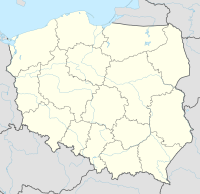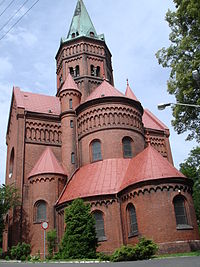Biały Kamień (Wałbrzych)
Location in Poland |
Biały Kamień (German Weißstein ) is a district of the city Wałbrzych (German Waldenburg ) in the Lower Silesian Voivodeship in Poland.
geography
Biały Kamień is located on the north-western outskirts of Wałbrzych. Neighboring towns are Konradów in the north, Stary Zdrój in the northeast, Sobięcin in the south, Jabłów in the west and Lubomin in the northwest.
history
Weißstein was probably founded together with the villages around "Salzborn" in the 13th century and was first mentioned in 1305 in the Breslau episcopal interest register as "Albus Lapis alias Wissenstein". It belonged to the castle district of Neuhaus Castle in the Duchy of Schweidnitz and came together with this after the death of Duke Bolko II in 1368 to Bohemia . However, Bolko's widow Agnes von Habsburg was entitled to usufruct until her death in 1392 . The Neuweißstein colony was probably founded at the end of the 16th century . Ten farmers are mentioned for the year 1676, in 1619 there were 31 farmers. During the Thirty Years War , Weißstein fell largely desolate, so that in 1636 only 50 of 114 houses were still inhabited. In 1733 Weißstein was acquired by the Counts Hochberg auf Fürstenstein . In 1740 there were 452 residents in Weißstein.
After the First Silesian War in 1742, Weißstein and almost all of Silesia fell to Prussia . In 1745 a teacher was hired, ten years later the Konradsthal colony from Weißstein became an independent community. On November 26th, 1800 a fire destroyed numerous houses and farms. After the reorganization of Prussia, Weißstein belonged to the province of Silesia from 1815 and was incorporated into the Waldenburg district from 1816 , with which it remained connected until 1945. In 1810 the colony of Neusalzbrunn was established . In 1818 the number of inhabitants was 727, in 1840 there were 1,415 inhabitants.
Since 1874, the rural community of Weißstein was the seat of the district of the same name , which existed until 1945. In 1869 and 1889 miners' strikes took place throughout the district. In 1878 Weißstein received a rail connection on the Waldenburg – Halbstadt line . Two years later the Protestant church was built and in 1888 an artificial ruin was built on the neighboring high forest plateau. In 1899 a catholic church was consecrated. In 1903 part of Neuweißstein was transferred to Waldenburg, in 1907 Weißstein was connected to the Waldenburger Kreisbahn . On October 1, 1921, part of Neusalzbrunn was incorporated into Waldenburg and two years later all of Neuweißstein . In 1925 there were 11,106 residents in Weißstein. After Konradsthal and Hartau were incorporated into Weißstein in 1935, the number of inhabitants rose to 17,349 in 1939. This made Weißstein the second largest municipality in the Waldenburger Bergland.
As a result of the Second World War , Weißstein fell to Poland in 1945, like almost all of Silesia, and was renamed Biały Kamień . Most of the German population was expelled, unless they had already fled. Some of the new residents were displaced from eastern Poland . In 1951 Biały Kamień was incorporated into the town of Wałbrzych, with which it shares its further history.
Hard coal mining
The hard coal mining in the area of Weißstein was first mentioned in 1561. Numerous explorations of mine fields were made in the 19th century, when mining reached its greatest development.
- The "Fuchs-Stollen" is documented for the first time in 1726. In 1793 it was expanded into a navigable mine and mining stopped in 1867.
- In 1780 the "Fuchs-Grube" was the second largest mine in the Waldenburg coal field . In the 19th century it became the largest mine and in 1891 employed 2,343 people. In the same year, 477,133 tons of coal were mined.
- In 1789 the "Julius-Schacht" was opened, on which from 1867 on was converted to civil engineering. Today there is a museum at this point.
- The "David Shaft" was also opened in 1789.
Personalities
- Fritz Büttner (1908–1983), German SPD politician
- Horst Tilch (1935–2004), President of the Bavarian Supreme Court
literature
- Heinrich Bartsch: Unforgettable Waldenburg homeland . Norden (Ostfriesland) 1969, pp. 356-357.
Web links
- District of Weißstein
- Historical and current recordings as well as geographical location
- History of Weißstein
Individual evidence
Coordinates: 50 ° 47 ' N , 16 ° 15' E


